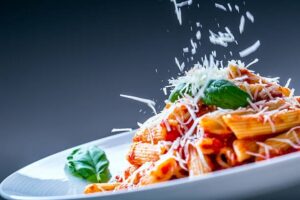Posts in Category: Food
Takeaway Pasta Quick Service: The Benefits and Disadvantages of Pasta
Takeaway pasta quick service gives an easy and delicious staple food made of unleavened dough made of wheat flour mixed with water or eggs, shaped into various forms, then cooked by boiling. Pasta provides plenty of carbohydrates as well as essential minerals and nutrients like iron, calcium, and phosphorus.
Cooking pasta can be a simple, satisfying, and delicious way to add flair and variety to any meal! By including vegetables, lean meats, and healthy fats into the mix, pasta becomes a nutritious meal that provides balanced nutrition.
Origin
 Pasta used to be seen as the food of poor people; however, with recent nutritional guidelines and renewed interest in the Mediterranean diet it has now taken its place as part of an appealing food pyramid. Pasta first came into use around 12th-13th centuries in southern Italy.
Pasta used to be seen as the food of poor people; however, with recent nutritional guidelines and renewed interest in the Mediterranean diet it has now taken its place as part of an appealing food pyramid. Pasta first came into use around 12th-13th centuries in southern Italy.
Some historians claim Marco Polo brought pasta from China into Italy. But archeological evidence proves this theory false.
North Africans have enjoyed eating itriyya for millennia. Believed to be its precursor, itriyya resembles modern pasta with its combination of wheat and barley flour as well as drying for easier transportation during long journeys – much like modern day pasta is. Additionally, its shape suggested its eventual transformation into noodles.
Types
Takeaway pasta quick service is an integral component of many diets across the globe, providing high amounts of proteins, carbohydrates, ash and minerals like calcium, potassium, phosphorus, iron and thiamine. Plus, its versatile shape works great with almost every sauce!
Long noodles like spaghetti, fettuccine, macaroni and penne are an ideal complement to creamy or dense sauces, while corkscrew-shaped pasta noodles (rotini or penne) with their angled edges are suitable for thick sauces.
Orzo and conchiglie pasta shapes feature open centres that make them great for holding onto creamy or chunky meat sauces, as well as soups.
Ingredients
From winter comfort food to summer picnic favourites, pasta is beloved food that brings people together. However, even with all its appeal comes its drawbacks.
Cooked plain pasta provides six grams of protein and carbohydrates with moderate levels of b-vitamin and iron content, providing an energy dense option that pairs perfectly with vegetables and healthy fats for an excellent nutritional meal.
Preparing pasta is straightforward: just combine water and your desired ingredients before stirring until fully mixed. But there are some key steps you should keep in mind for optimal results.
Before adding the pasta, bring a large pot of heavily salted water to a rolling boil, stirring frequently. This step may be easily overlooked but is essential to ensure it cooks evenly and doesn’t stick together during baking. Furthermore, using flavourful boiling water adds another dimension of flavouring your final dish!
Preparation
No matter if you prefer pasta salads or saucy noodles, it’s crucial to cook pasta properly. Even minor errors and miscalculations in cooking techniques could leave your noodles tasting less flavourful or undercooked altogether.
As may seem obvious, never add your pasta to boiling water until it has actually started bubbling. If using a large pan, cover it with its lid to help accelerate this process.
Be careful not to rinse your pasta once cooked and mixed with sauce – doing so would remove valuable starch that helps the sauce adhere better to the noodles, and could prevent your pasta from sticking together too much when ready to serve it. Instead, save some of the pasta water as you may use this when loosening the noodles for service – this can also prevent excessive stickiness!
Cooking
Pasta undergoes a drying process before packaging to preserve it for longer, which necessitates being cooked to rehydrate properly – which makes rinsing unnecessary! To get maximum flavour from this meal, avoid doing this step and do not rinse the pasta prior to its cooking time.
Rinsing pasta after it has been thoroughly dried removes starch that allows it to adhere to other ingredients and can result in soggy noodles. To avoid this situation, it’s best to immediately place it into boiling water once dried completely and add your pasta as soon as it has been thoroughly dryened.
Cook your pasta until it reaches ‘al dente,’ meaning that you can still chew and appreciate its texture. Another essential step to ensure maximum flavour in your pasta dish is heavily salting the water used for boiling it.




